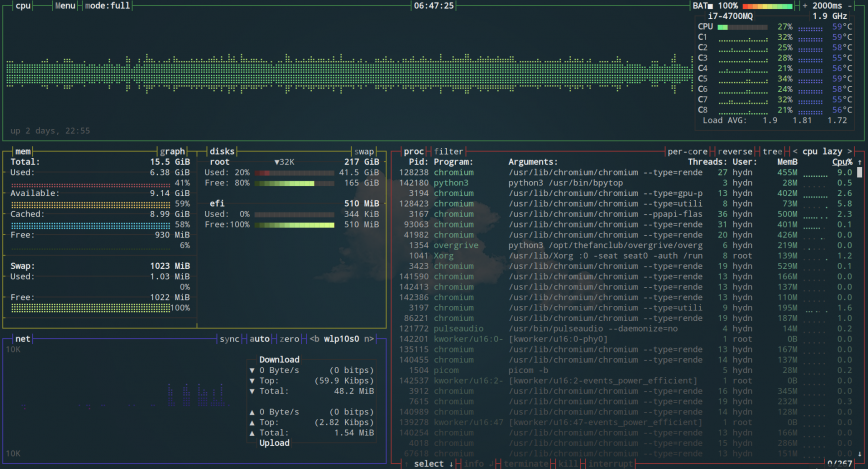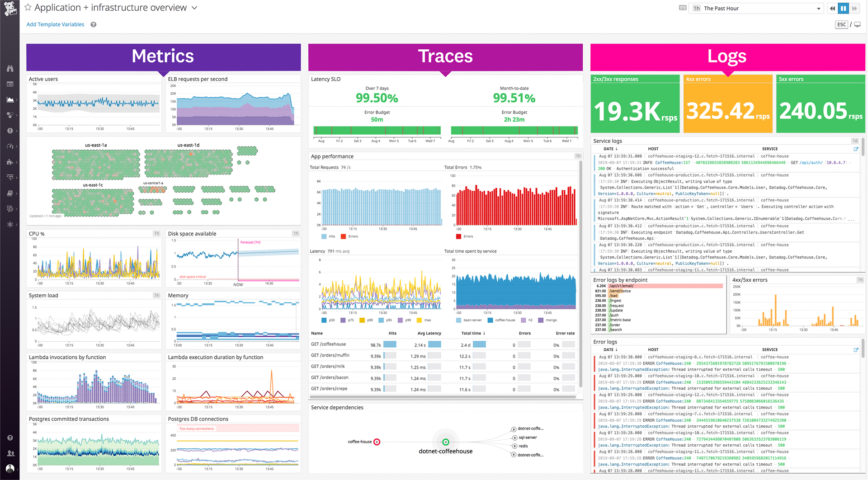90 Linux Commands frequently used by Linux Sysadmins
There are well over 100 Unix commands shared by the Linux kernel and other Unix-like operating systems. If you are interested in the commands frequently used by Linux sysadmins and power users, you’ve come to the place. Recently, I published a five-part series covering commands often used by Linux sysadmins.
Below I’ve listed the 90 commands covered and links to each of the five posts in this series. Some of the commands listed include links to related articles. There are also thousands of commands available if we include downloadable software and scripts, such as bpytop (pictured below). However, for this article’s purpose, we will cover mostly Unix commands used on Linux by sysadmins and power users. If you find this page useful, let me know if you’d like to see similar posts in the future.
Pictured: bpytop – There are many system/server monitoring and network command-line tools available.
Linux Commands frequently used by Linux Sysadmins – Part 1:
1. ip – from Iproute2, a collection of utilities for controlling TCP/IP networking and traffic control in Linux.
2. ls – list directory contents.
3. df – display disk space usage.
4. du – estimate file space usage.
5. free – display memory usage.
6. scp – securely Copy Files Using SCP, with examples.
7. find – locates files based on some user-specified criteria.
8. ncdu – a disk utility for Unix systems.
9. pstree – display a tree of processes.
10. last – show a listing of last logged-in users.
11. w – show a list of currently logged-in user sessions.
12. grep – Search a file for a pattern of characters, then display all matching lines.
Sponsored: Datadog – See inside any stack, any app, at any scale, anywhere.
Datadog is a unified monitoring, analytics, and security platform that offers end-to-end monitoring for your Linux applications alongside metrics and events from 450+ other technologies for a unified view of your entire infrastructure. With correlated infrastructure monitoring, application performance monitoring, log management, security tools, and more, Datadog enables Dev, Ops, and Security teams to work collaboratively to help organizations avoid downtime, resolve performance problems fast, and ensure that development and deployment cycles finish on time.
Linux Commands frequently used by Linux Sysadmins – Part 2:
13. uptime – shows system uptime and load average.
14. top – shows an overall system view.
15. vmstat – shows system memory, processes, interrupts, paging, block I/O, and CPU info.
16. htop – interactive process viewer and manager.
17. dstat – view processes, memory, paging, I/O, CPU, etc., in real-time. All-in-one for vmstat, iostat, netstat, and ifstat.
18. iftop – network traffic viewer.
19. nethogs – network traffic analyzer.
20. iotop – interactive I/O viewer. Get an overview of storage r/w activity.
21. iostat – for storage I/O statistics.
22. netstat – for network statistics.
23. ss – utility to investigate sockets.
24. atop – For Linux server performance analysis.
25. Glances and nmon – htop and top Alternatives:
26. ssh – secure command-line access to remote Linux systems.
27. sudo – execute commands with administrative privilege.
28. cd – directory navigation.
29. pwd – shows your current directory location.
30. cp – copying files and folders.
31. mv – moving files and folders.
32. rm – removing files and folders.
33. mkdir – create or make new directories.
34. touch – used to update the access date and modification date of a computer file or directory.
35. man – for reading system reference manuals.
36. apropos – Search man page names and descriptions.
Linux Commands frequently used by Linux Sysadmins – Part 3:
37. rsync – remote file transfers and syncing.
38. tar – an archiving utility.
39. gzip – file compression and decompression.
40. bzip2 – similar to gzip. It uses a different compression algorithm.
41. zip – for packaging and compressing (to archive) files.
42. locate – search files in Linux.
43. ps – information about the currently running processes.
44. Making use of Bash scripts. Example: ./bashscript.sh
45. cron – set up scheduled tasks to run.
46. nmcli – command-line tool for controlling NetworkManager.
47. ping – send ICMP ECHO_REQUEST to network hosts.
48. traceroute – check the route packets take to a specified host.
49. mtr – network diagnostic tool.
50. nslookup – query Internet name servers (NS) interactively.
51. host – perform DNS lookups in Linux.
52. dig – DNS lookup utility.
Linux Commands frequently used by Linux Sysadmins – Part 4:
53. wget – retrieve files over HTTP, HTTPS, FTP, and FTPS.
54. curl – transferring data using various network protocols. (supports more protocols than wget)
55. dd – convert and copy files.
56. fdisk – manipulate the disk partition table.
57. parted – for creating and manipulating partition tables.
58. blkid – command-line utility to locate/print block device attributes.
59. mkfs – build a Linux file system.
60. fsck – tool for checking the consistency of a file system.
61. whois – client for the whois directory service.
62. nc – command-line networking utility. (Also, see 60 Linux Networking commands and scripts.)
63. umask – set file mode creation mask.
64. chmod – change the access permissions of file system objects.
65. chown – change file owner and group.
66. chroot – run command or interactive shell with a special root directory.
67. useradd – create a new user or update default new user information.
68. userdel – used to delete a user account and all related files.
69. usermod – used to modify or change any attributes of an existing user account.
Linux Commands frequently used by Linux Sysadmins – Part 5:
70. vi – text editor.
71. cat – display file contents.
72. tac – output file contents, in reverse.
73. more – display file contents one screen/page at a time.
74. less – similar to the more command with additional features.
75. tail – used to display the tail end of a text file or piped data.
76. dmesg – prints the message buffer of the kernel ring.
77. journalctl – query the systemd journal.
78. kill – terminate a process.
79. killall – Sends a kill signal to all instances of a process by name.
80. sleep – suspends program execution for a specified time.
81. wait – Suspend script execution until all jobs running in the background have been terminated.
82. nohup – Run Commands in the Background.
83. screen – hold a session open on a remote server. (also a full-screen window manager)
84. tmux – a terminal multiplexer.
85. passwd – change a user’s password.
86. chpassword – allows users to change the password for various user accounts.
87. mount / umount – provides access to an entire filesystem in one directory.
88. systemctl – central management tool for controlling the init system.
89. clear – clears the screen of the terminal.
90. env -Run a command in a modified environment.
Misc commands:
91. cheat – allows you to create and view interactive cheatsheets on the command line.”
92. tldr – Collaborative cheatsheets for console commands.
93. bashtop – the ‘cool’ top alternative.
94. bpytop – Python port of bashtop.
95. btop – C++ version and continuation of bashtop and bpytop.
96. nload – a super simple, command-line network interface monitoring tool.
97. history – used to view the previously executed commands.
98. sar – collects, reports, and saves system activity information, including CPU, memory, disk, and network usage.
I referred to commands as “Linux commands” since this blog and this article is specific to Linux admins and users. However, these are indeed Unix Commands for Unix and other Unix-like operating systems such as Linux.
Published: November 1st, 2020 / Last updated: April 5th, 2023

